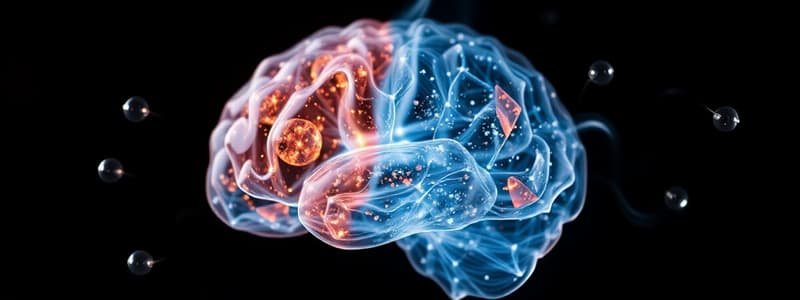Podcast
Questions and Answers
What does General Fluid Intelligence (Gf) primarily involve?
What does General Fluid Intelligence (Gf) primarily involve?
- Ability to grasp relations and deal with novelty. (correct)
- Acquired knowledge from education.
- Memory and perceptual speed.
- Verbal reasoning and comprehension.
Which of the following is NOT one of Thurstone's primary mental abilities?
Which of the following is NOT one of Thurstone's primary mental abilities?
- Simultaneous Reasoning (correct)
- Verbal Comprehension
- Spatial Ability
- Numerical Fluency
How is the reliability of a psychological test primarily measured?
How is the reliability of a psychological test primarily measured?
- By evaluating the test's ability to predict real-life performance.
- By comparing scores across different cultures.
- By the consistency of scores obtained from the same individuals over time. (correct)
- By the diversity of the population sampled in the test.
What aspect distinguishes General Crystallized Intelligence (Gc) from General Fluid Intelligence (Gf)?
What aspect distinguishes General Crystallized Intelligence (Gc) from General Fluid Intelligence (Gf)?
Which theory emphasizes both fluid and crystallized intelligence as distinct but related types?
Which theory emphasizes both fluid and crystallized intelligence as distinct but related types?
What role does performance on a task typically require according to Gf-Gc Theory?
What role does performance on a task typically require according to Gf-Gc Theory?
What kind of abilities fall under General Fluid Intelligence (Gf)?
What kind of abilities fall under General Fluid Intelligence (Gf)?
According to the Gf-Gc Theory, which type of intelligence may require an investment of fluid intelligence to develop?
According to the Gf-Gc Theory, which type of intelligence may require an investment of fluid intelligence to develop?
Which of the following abilities is primarily associated with fluid intelligence (Gf)?
Which of the following abilities is primarily associated with fluid intelligence (Gf)?
What is the main characteristic of crystallized intelligence (Gc) as compared to fluid intelligence (Gf)?
What is the main characteristic of crystallized intelligence (Gc) as compared to fluid intelligence (Gf)?
What does a good psychological assessment primarily depend on?
What does a good psychological assessment primarily depend on?
Which of the following traits is most likely to measure crystallized intelligence (Gc)?
Which of the following traits is most likely to measure crystallized intelligence (Gc)?
What does the Gf-Gc theory suggest about the relationship between fluid and crystallized intelligence?
What does the Gf-Gc theory suggest about the relationship between fluid and crystallized intelligence?
How does fluid intelligence (Gf) develop as individuals age?
How does fluid intelligence (Gf) develop as individuals age?
Which factor is not a consideration for the reliability of a psychological test?
Which factor is not a consideration for the reliability of a psychological test?
What is meant by the term 'validity' in the context of psychological assessments?
What is meant by the term 'validity' in the context of psychological assessments?
What does Cronbach’s α reflect in a test?
What does Cronbach’s α reflect in a test?
What is the formula relating observed score, true score, and error?
What is the formula relating observed score, true score, and error?
Which type of validity assesses whether a test measures its intended variable appropriately?
Which type of validity assesses whether a test measures its intended variable appropriately?
What is an example of systematic error variance in measurement?
What is an example of systematic error variance in measurement?
Which method involves measuring the same group of people twice on the same test?
Which method involves measuring the same group of people twice on the same test?
What could cause an over-estimation of reliability during a test-retest scenario?
What could cause an over-estimation of reliability during a test-retest scenario?
How is content validity primarily assessed?
How is content validity primarily assessed?
Which aspect of validity ensures that a test measures distinct constructs from unrelated psychological phenomena?
Which aspect of validity ensures that a test measures distinct constructs from unrelated psychological phenomena?
Which score reflects zero net error in the error column of the observations?
Which score reflects zero net error in the error column of the observations?
What is the primary focus of convergent validity?
What is the primary focus of convergent validity?
Why might changes in observed scores from time 1 to time 2 not solely indicate measurement error?
Why might changes in observed scores from time 1 to time 2 not solely indicate measurement error?
Which statistic is commonly used to assess reliability of a test?
Which statistic is commonly used to assess reliability of a test?
What could systematic error variance potentially impact in a test?
What could systematic error variance potentially impact in a test?
Which of the following describes a situation that could lead to low test-retest reliability?
Which of the following describes a situation that could lead to low test-retest reliability?
What is meant by defining the boundaries and structure of a domain in content validity?
What is meant by defining the boundaries and structure of a domain in content validity?
What is the average observed score provided in the observations?
What is the average observed score provided in the observations?
What does a reliable test primarily distinguish between?
What does a reliable test primarily distinguish between?
Which of the following components make up the observed score in Classical Test Theory?
Which of the following components make up the observed score in Classical Test Theory?
Which source of error involves variations in the administration of the test?
Which source of error involves variations in the administration of the test?
What is a characteristic of the True Score?
What is a characteristic of the True Score?
What does the equation $X = T + E$ signify in Classical Test Theory?
What does the equation $X = T + E$ signify in Classical Test Theory?
In Classical Test Theory, what is true about the error component?
In Classical Test Theory, what is true about the error component?
Why is it impossible to know the True Score with certainty?
Why is it impossible to know the True Score with certainty?
What can be inferred from repeated measurements in estimating the True Score?
What can be inferred from repeated measurements in estimating the True Score?
Flashcards are hidden until you start studying
Study Notes
Theory Development
- The single factor ‘g’ theory, proposed by Charles Spearman in 1927, suggests that intelligence is a single underlying factor. This theory is supported by the “positive manifold” wherein performance on various intellectual tasks tends to be positively correlated.
- The primary mental abilities theory, developed by Louis Leon Thurstone in 1938, posits that intelligence is composed of seven distinct abilities: verbal comprehension, inductive reasoning, numerical fluency, word fluency, spatial ability, memory, and perceptual speed.
- Hierarchical models of intelligence suggest that there is a general intelligence factor (g) from which more specific abilities branch out.
Gf-Gc Theory
- The Gf-Gc theory, developed by Raymond Cattell in 1941, is one of the most commonly used intelligence theories.
- The theory proposes two main types of intelligence: general fluid intelligence (Gf) and general crystallized intelligence (Gc).
- General fluid intelligence (Gf) refers to the ability to deal with novel situations, grasp relations between things, and engage in inductive and deductive reasoning. It is considered non-verbal, culture-free, and thought to reflect innate cognitive abilities.
- General crystallized intelligence (Gc) refers to acquired knowledge and skills. It is influenced by culture, education, and past experiences. The theory posits that Gf is necessary for the development of Gc.
Gf-Gc Theory: First Order Abilities
- Gf includes abilities such as induction, sequential reasoning, quantitative reasoning, temporal tracking, and figural reasoning.
- Gc includes abilities such as verbal comprehension, cognition of semantic relations, general information, reading comprehension, spelling, verbal closure, phonetic coding, and foreign language aptitude.
Evidence for Gf and Gc as Distinct Constructs
- While Gf and Gc are conceptually distinct, they are correlated.
- One of the strongest pieces of evidence for their distinct nature comes from their developmental trajectories:
- Gf tends to increase until young adulthood and then decline in old age.
- Gc typically increases and plateaus over time.
How to Assess Psychological Abilities
- Psychological assessment aims to measure traits or abilities and ensure that assessment instruments produce accurate and meaningful results.
- The quality of a psychological assessment depends on two key factors: reliability and validity.
- Reliability refers to the consistency of an assessment tool in measuring a trait or ability. It tells us how well the tool separates individuals who truly differ on the construct.
- Validity refers to how well an assessment tool measures what it claims to measure. It also signifies the appropriate use of the tool for its intended purpose.
Classical Test Theory
- Classical test theory (CTT) assumes that every observed score is composed of a true score and an error component.
- The true score represents the true level of ability while the error component encompasses random variance.
- Sources of error in CTT include test construction, administration, scoring, and interpretation subjectivity.
Reliability Estimation Methods
- Test–retest reliability: Assesses the consistency of scores over time by administering the same test to the same individuals on two separate occasions. The correlation between the two administrations indicates the test's reliability.
- Equivalent forms reliability: Involves using two different forms of the same test to measure the same construct. The reliability of the test is reflected in the correlation between scores on the two forms.
- Split-half reliability: Involves dividing a single test into two halves and correlating the scores on the two halves.
- Cronbach’s alpha: A measure of internal consistency that reflects the average of all possible split-half correlations within a test; it indicates the extent to which all items measure the same construct.
Considerations for Reliability
- Carry-over effects (e.g., remembering responses from the first administration) can artificially inflate reliability estimates, especially when the retest interval is short.
- Changes in true scores over time due to maturation or reactivity can influence reliability estimates.
Systematic Error and Validity
- Systematic error is a consistent error that occurs across all measurements. It does not affect reliability estimates but reduces the validity of the test, as it distorts the true measurement.
Validity
-
Validity is divided into two main aspects:
- Construct Validity
- Content Validity
-
Construct validity refers to the extent to which a test measures the theoretical construct it is intended to measure.
-
Convergent validity establishes whether the construct being measured is related to other similar constructs/tests. It is expected that a test measuring a particular construct will show high correlations with other tests or measures designed to assess the same or similar constructs.
-
Discriminant validity ensures that the construct being measured is distinct from other, theoretically unrelated, psychological constructs.
-
Content validity refers to how well a test represents the entire domain of behavior it is intended to measure.
-
Coverage of the domain: Content validity ensures that the test assesses a representative sample of behaviors from the intended domain.
-
Defining boundaries and structure: Content validity requires clear boundaries of the domain (defining what is and isn't included) and a structure that reflects the organization of the domain.
Studying That Suits You
Use AI to generate personalized quizzes and flashcards to suit your learning preferences.



